From the series of articles "Lightning protection of high-rise buildings".
Everything starts from the corona. This form of electrical discharge is well known not only to specialists. The fans of pirate novels read about the flickering glow on the tops of the masts of sailing ships in stormy conditions. The phenomenon was called St. Elmo fire. It is the corona discharge in an electric field of a thunderstorm cloud. In its reflexes, it is not much different from the corona to the phase wires of overhead power lines. The weak glow of the corona in an urban environment is difficult to distinguish even at night, but its characteristic crackling in bad weather (rain, fog, sleet) is well heard and causes quite sensitive interference in the medium radio frequency.
In a stormy environment the corona arises not only from the high-rise buildings but many-meter antenna towers. Branches of trees and shrubs and even sharp grass feathers can coronate. The current of such corona is very weak. In fig. 1 there is the dynamics in the corona current change from the rod electrodes of different heights. The Ostankino television tower is the highest (540 m). It is analytically shown that the current value is sensitive to growth rate of the atmosphere electric field E0 so for the estimations above, a fairly high recovery rate is entered into the computer calculation E0 in the inter-lightning pause - the electric field at the ground grew linearly up to 20 kV/m in 10 seconds, and did not change further. In the example analyzed, even at the maximum height of a large object, the corona current was weak.
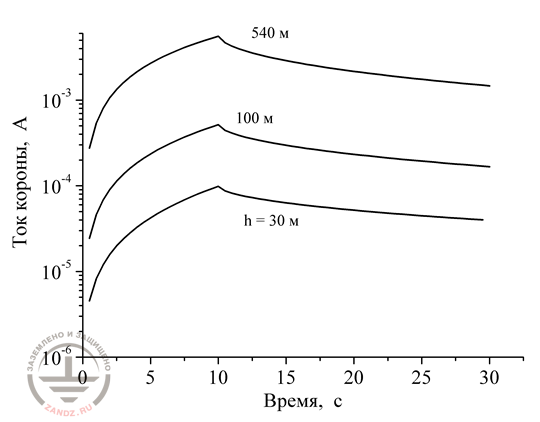
Figure 1. The dynamics of changes in the corona current from the electrodes of different heights. The electric field of a thunderstorm cloud increases linearly up to 20 kV / m in 10 seconds, and doesn't change further.
Ток короны, А- corona current, A
Время, с – time, s
Its value doesn't exceed a few milliamperes. However, at the apex of the grounded structure a space charge was accumulated, which equalizes the electric field in the electrode sheath. The levelling result can be seen from the calculated data in Fig. 2.
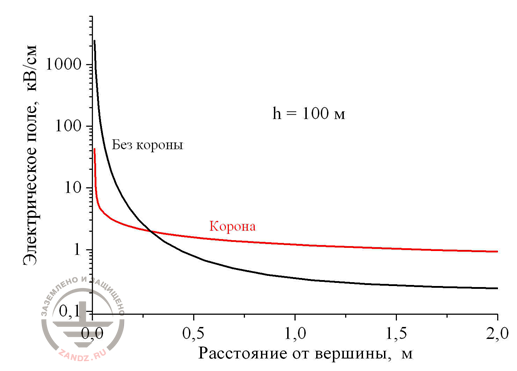
Figure 2. The distribution of the electric field above the top of the object 100 m high
Электрическое поле кВ/см- electric field kV/cm
Расстояние от вершины,м – Distance from the top, m
Без короны – without corona
Корона- corona
With such a low energy input, the electrical discharge from the top of the electrode is not accompanied by an increase of the plasma channel, and exists only in the form of the ionization zone of a very limited size, the length of which is comparable to the radius of the corona top. The reason is that the formation of an extended channel requires a high conductivity of plasma in its volume at characteristic times of lightning developmened, reckoned in milliseconds. Plasma conductivity is determined by electrons. Their lifetime in cold air in the order of magnitude ranges from 10 - 7s. In order to prolong the existence of electrons to a millisecond range, the air must be heated to 5000 - 6000 K. This is possible if the corona discharge shifts to a streamer shape that is distinguished by the formation of extended plasma branches beam that start from a single stem (Fig. 3).
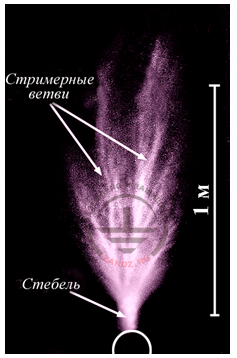
Figure 3. Static picture of a streamer flash
Стримерные ветви- streamer branches
Стебель- stem
1 м – 1 m
Energy deposition into streamer branches is also not great and they remain almost as cold as the ambient air, but the total current in the stem of many branches may be sufficient for the desired heating. It happens when the length of streamer branches is close to 1 m, and the voltage drop on them - approximately to 400 kV. A counter leader is formed in this hot stem.
Thus, the transition of the corona to the shape of a streamer is an exeptionally important aspect in forming a counter discharge, eventually "attracting" a lightning. The transition criterion is theoretically estimated and experimentally confirmed. It occurs when the corona current exceeds some critical value

If the object's apex has a radius r0 ≈ 2 cm, and for the excitation of the corona the electric field intensity on its surface must rise to a value E (r0) = Ecor = 4 × 104 V/cm, then with a typical corona ion mobility μ ≈ 1,5 cm2(V·s)-1 the corona critical current is estimated by the value ~ 10 mA. Even at the top of the Ostankino tower the corona is weaker. For objects of the same ordinary height in the electric field of a thunderstorm cloud, the corona current differs from the critical in the tens and hundreds of times. However, counter-leaders had been repeatedly observed in thunderstorm conditions of buildings of very different heights. It has been established that their birth is conditioned by the increase of the electric field in an atmosphere of an electric charge which is transported to the ground by a forming lightning channel. Here, not only (and not so!) the value of the transferred charge is important, but the high speed at which the field enhances.
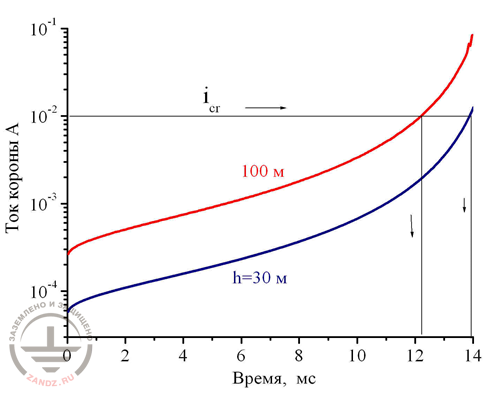
Figure 4. Growth dynamics of the corona current from the top of a lightning rod during the development of a downward lightning (timing from the lightning start moment)
Ток короны, А- corona current, A
Время, мс – time, ms
Calculated data in fig. 4 show the growth of corona current from the lightning rod h = 30 and 100 meters high after the start of lightning at an altitude of 3000 m, the channel of which is close to the ground with an average speed of 2×105 m/s along a vertical trajectory with a radial offset rM = 3h; linear channel charge is equal to 0.5 mCl/m (average lightning power). You can see, that the corona current exceeds the critical value ~ 10 mA when the lightning channel came down to a height of 600 m above the ground level at a lightning rod height of h = 100 m and up to a height of 200 m at h = 30 m, thus ensuring the transfer of the corona to a streamer form in about 12 and 14 ms for lightning conductors of 100 and 30m respectively. It is relevant to talk about the possibility of a counter-leader development, intercepting a lightning from the indicated time points.
The result of the interception process (better to say - the orientation process of a downward lightning) is ambiguous. Channels of the lightning and the counter leader may reunite, having predestined the strike into a lightning rod, and may "mishit". Then the lightnin will strike the ground or any other neighbouring object. In such a situation it is important to trace the fate of a newly born counter leader, having set the possibility of its further development to the storm cloud after hitting the ground by that very lightning that incited it with its electric field. In fig. 5 and 6 you see the results of computer simulation of two fundamentally different situations.
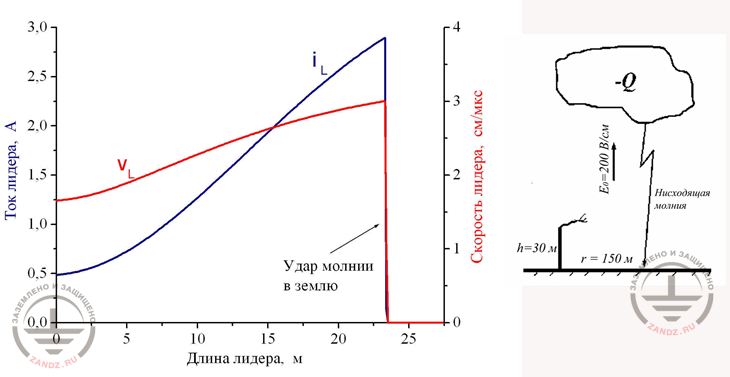
Figure 5. The results of computer calculation of counter leader parameters, started from the lightning rod 30 m high
Ток лидера, А – leader current, A
Удар молнии в землю – Lightning strike into the ground
Длина лидера, м- Leader length, m
Скорость лидера см/мкс – Leader speed cm/ms
Нисходящая молния- downward lightning
On the first of them, the incited counter leader moved from the top of the object 30 m in height with the speed of 2-3 cm / microsecond with the current of 0.5 - 3 A and reached a length of about 24 m to the moment when the "mishit" lightning struck the ground. With that, the lightning charge was neutralized, its electric field ceased to exist, which resulted in almost instantaneous slowdown of the counter leader (its current and the speed dropped to zero).
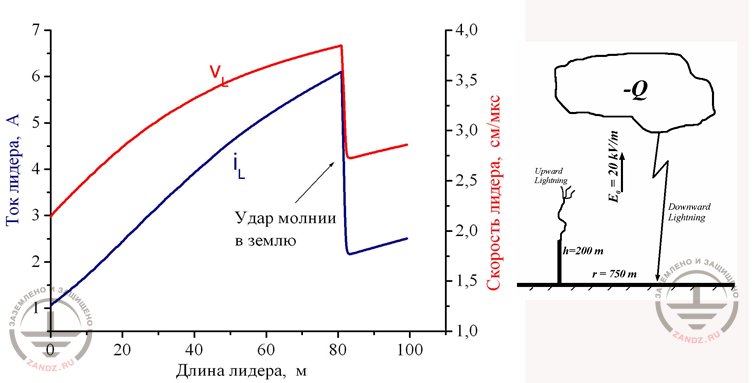
Figure 6. The results of computer calculation of counter leader parameters, started from the object 200 m in height
Удар молнии в землю – Lightning strike into the ground
Длина лидера, м- Leader length, m
Скорость лидера см/мкс – Leader speed cm/ms
Нисходящая молния- downward lightning
The sequence of events in Fig. 6 for an object 200 meters in height is fundamentally different. Here, the counter leader appeared before and moving with approximately the same speed like in the first example, by the moment of downward lightning strike into the ground managed to move up by about 80 m. Disappearance of the electric field of the lightning discharge slowed the counter leader down too. However, the development of the discharge was not stopped completely, - it continued to move to the storm cloud, albeit with the speed slowdown. The upward lightning was born so.
E. M. Bazelyan, DEA, professor
Energy Institute named after G.M. Krzyzanowski, Moscow
Read more "2. The number of lightning strikes into high-rise buildings".
Useful materials:
- Series of articles about lightning protection for beginners
- Series of webinars about grounding and lightning protection with Professor E. M. Bazelyan
- Elements of external lightning protection
- Consultations on the selection, design and installation of grounding and lightning protection systems
Related Articles:



